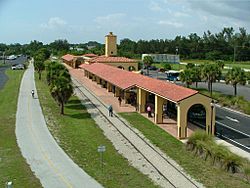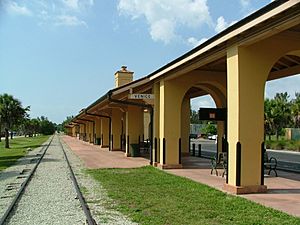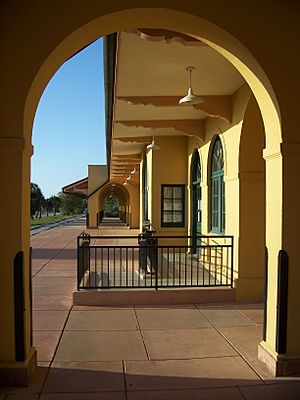Venice Seaboard Air Line Railway Station facts for kids
Quick facts for kids Venice Seaboard Air Line Railway Station |
|
|---|---|
 |
|
| Alternative names | Venice Depot |
| General information | |
| Architectural style | Mission/Spanish Revival |
| Location | Venice, Florida, U.S. |
| Address | 303 East Venice Avenue |
| Country | United States |
| Coordinates | 27°06′03″N 82°26′25″W / 27.10083°N 82.44028°W |
| Opened | March 27, 1927 |
| Cost | $47,000 ($605 thousand in 2021 dollars) |
| Client | Brotherhood of Locomotive Engineers |
| Owner | Sarasota County |
| Dimensions | |
| Diameter | 400 ft × 50 ft (122 m × 15 m) |
| Design and construction | |
| Architecture firm | Walker & Gillette |
|
Venice Seaboard Air Line Railway Station
|
|
| Lua error in Module:Location_map at line 420: attempt to index field 'wikibase' (a nil value). | |
| MPS | Venice MPS |
| NRHP reference No. | 89001072 |
| Added to NRHP | August 17, 1989 |
The Venice Seaboard Air Line Railway Station, also called the Venice Depot, is an old train station in Venice, Florida. You can find it at 303 East Venice Avenue. This station is the starting point of the Legacy Trail, a popular path for biking and walking. It also serves as a busy spot for local buses run by Sarasota County Area Transit (SCAT). Because it's so important to history, it was added to the U.S. National Register of Historic Places on August 17, 1989.
Contents
How the Venice Train Station Began
The Seaboard Air Line (SAL) was the first railroad company to build tracks into Sarasota County. They reached Sarasota in 1903 and Fruitville in 1905. The SAL extended their tracks to Venice in 1911. This happened because Mrs. Potter Palmer, whose family owned a lot of land nearby, wanted the railroad to come to Venice. The very first train station in Venice was located where Tampa and Nokomis Avenues are today.
In 1925, a man named Fred H. Albee bought a large piece of land in Venice. He had big plans to design a city there. However, a group called the Brotherhood of Locomotive Engineers (BLE) offered to buy the land from him. The BLE was a union for train workers, and they wanted to own more property in the area.
Designing the New Station
The BLE created a company to develop the land and sell properties. They hired John Nolen to finish the city plan in 1926. Nolen decided to move the SAL train tracks to where the Venice station is now.
The new train station was designed by a New York company called Walker & Gillette. This company also designed many other new buildings in Venice. They made the station look like other buildings in the city. They used a style called Mediterranean Revival. This style was popular in Florida because of its warm weather and Spanish history.
The station has simple, light-colored walls and gently sloped red tile roofs. These are key features of the Mediterranean Revival style. The building's structure under the stucco was made from hollow clay tiles.
A Grand Welcome for Travelers
Even though Venice was a small town, the train station was very large and impressive. It had a long platform, about 400 feet long. There were also rooms for baggage and freight. A tall tower stood out, and long covered walkways (arcades) ran along the platform. Like many places at the time, it had separate waiting rooms for white and Black passengers.
The station was built so big because the people who planned Venice hoped it would grow into a large city. They wanted a grand place to welcome many train passengers. The station cost about $47,500 to build. It officially opened on March 27, 1927.
The Station's Busy Years
For the next 45 years, the Venice Seaboard Air Line Depot was a very important place for the city. Famous trains like the Camellia and the Orange Blossom Special stopped there.
Every year, students and teachers from the Kentucky Military Institute would arrive at the station for their winter classes. This started in January 1933. During World War II, starting in 1942, the station became the main entry point for U.S. Army supplies and soldiers. This was because the Army had an air base in Venice.
In the 1960s, fewer people were traveling by train across the U.S. However, the Ringling Bros. and Barnum and Bailey Circus used the station. They moved to Venice in 1960 and used the station to ship their equipment and operations around the country.
In 1967, the Seaboard Air Line merged with another railroad, the Atlantic Coast Line Railway. The new company was called Seaboard Coast Line. Passenger train service to the station finally stopped on April 30, 1971. This happened because almost all passenger trains in the country were combined into a new company called Amtrak the next day.
The Station Today
In 1998, Sarasota County bought the building. It is the last old train station left in the county. The local government worked to fix up the building, even doing archaeological digs.
Today, the city of Venice has made the station's grounds part of the Venetian Waterway Park. This park runs along both sides of the Gulf Intracoastal Waterway, which is next to the station. The old train tracks have mostly been removed.
The station now houses the Venice Area Historical Society Museum. It also has event space that people can rent for parties or meetings. Buses pick up passengers from the covered waiting area at the south end of the station.
Near the north end of the station, there's an old red Seaboard Air Line freight car. It has been restored and is now used as offices for the Historical Society. A special historical marker was put up in 2003 by the Sarasota County Historical Commissions.



